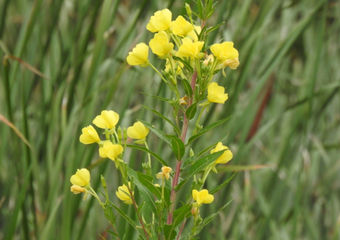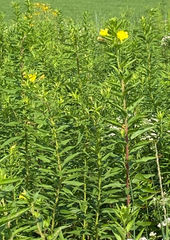Common Evening Primrose
Common Name: Common Evening Primrose.
Scientific Name: Oenothera Biennis.
What to look for? In the mornings – or if you are a night owl, evenings, look for a tall stem with a panicle of four-petaled, yellow flowers. The Common Evening Primrose is generally known for flowers that close during most of the daylight hours, remaining open only from evening to early morning. It has a tall, unbranched green stem. The leaves are basal for first year. During the second year, the flowering stem rises with long, alternate, lance-like leaves that become shorter near the top of the stem. The inflorescence is a stiff spike of many flowers which open from the base of the spike and progress upward as the spike elongates. Sometimes there are short, side branches with flowers. The flowers are 4-petaled with yellow corollas. As the blooming flowers move upward, seed capsules, or pods, form under them in a spiral pattern around the spike. These seed capsules contain several hundred small reddish-brown seeds. The capsule opens at the top, seeds are dispersed by wind shaking the stem. Seeds can germinate in four weeks and will form a rosette, then the plant over-winters and flowers the following year.
Where can they be found at Carillon Stonegate Pond? Common Evening Primrose pop up in the meadow areas around Carillon Stonegate Pond, the restored prairie around Stonegate Park, and around the fields near Arlene Shoemaker forest preserve.
How big are they? Tall! Common Evening Primrose grows from two (2) feet up to six (6) or more feet tall. The large, but narrow leaves are six (6) to eight (8) inches long and one (1) to two (2) inches across. Each flower head is approximately one (1) inch across.
Where do they grow and thrive? The Common Evening Primrose is native to Illinois and is found most of the counties. Across the U.S., it is found between the east coast and the Rockies and also on the West Coast. Primary habitats include in open disturbed areas such as prairies, thickets, glades, lakeshore dunes, fields, pastures, gardens, roadsides, and waste places.
When do they bloom? The blooming period of the Common Evening Primrose is throughout summer to early fall. The flowers close during daylight hours, although the flowers are usually partially open until noon.
Do birds, insects or other wildlife associate with this plant? Sphinx moths pollinate the flowers of the Common Evening Primrose. Other occasional nectar-seeking visitors include honeybees, bumblebees, and the Ruby-Throated Hummingbird. The seeds are eaten by goldfinches.
Interesting Facts About the Common Evening Primrose:
-
The genus name Oenothera, comes from two Greek words, oinos for "wine" and thera for "to imbibe".
-
Specific epithet identifies the biennial growing cycle of this plant.
-
Flowers open at dusk and close again in the morning when hit by sun, hence the common name of evening primrose.
-
There are medicinal uses of the plant recorded by Cherokee, Iroquois, Ojibwa, and Potawatomi Native Americans.
For more information on the Common Evening Primrose and sources of information used in this blog (these are several of the sources that I am using to learn as I blog), please visit Illinois Wildflowers, Minnesota Wildflowers, Missouri Botanical Garden, Friends of the Wildflower Garden, and Happy DIY Home.
The Carillon at Stonegate community is very fortunate to have a variety of wetland, forest and prairie environments conducive to a variety of birds and other wildlife, insects and plants. Our community and the Kane County Forest Preserve do an exceptional job in maintaining this natural environment – both for the benefit of the birds and wildlife and for our residents to enjoy.
Take a hike and see what you can find – and identify!










